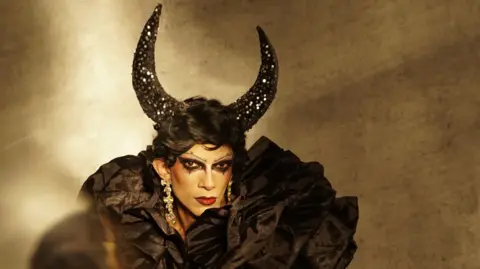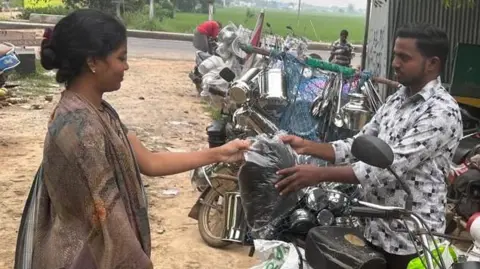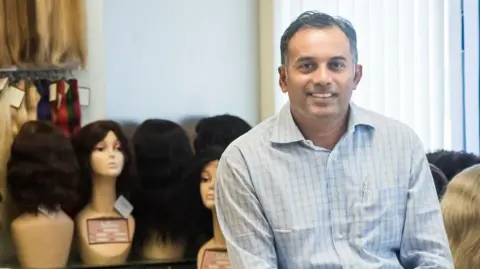[ad_1]
Technical reporter, Mumbai
 Rami
RamiJishan Ali has been a traction artist for 10 years and has taken his show across India.
The center of his performance is a collection of about 45 wigs.
“This is a change of identity. This helps me to become exaggerated, attractive or strange characters from my daily self. The right Vig makes me very credible and gives me the power to command the stage,” says Ali in Mumbai.
But getting that look correct is not easy in the early days.
“When I started my life, Vicks’s access was very difficult in India. Most of them were to be obtained from abroad, or I used to create Vigs from wool and fabric,” he says.
But now things are different.
“The trend changes. Wicks are no longer for drag or film artists, but many straight women will wear wig to make it look different. This is no longer a hair companion, but a style report. ”
Indian hair should always be prepared. The nation is the world’s largest exporter of human hair, which provides 85% of the global needs.
Koalachi Venkatesh, who is a source of Chennai’s embarrassment, has been collecting hair for 20 years. He started as a choice at the base of the industry – collected hair from homes and rescued from trash.
“My parents are hair -holders. Then I started doing the same,” he says.
Hair collected by those who take homes, salon and barber stores is called non -remi hair.
This requires more processing than Remy hair, which is carefully shaved from the scalp. Nevertheless, it is worth it.
“It was lifted now, but it was gold,” says Mr Venkatesh.
Those selectors usually sell hair from 10 cents to $ 1 (£ 0.80) per kg depending on the quality and length of the hair for local traders like Mr. Venkatesh.
Short or damaged hair gets less, while long fibers bring more prices.
For the individual selector, there is not much money in it.
“A diligent collector may collect 1–5 kilograms of hair a day, from 59 cents to $ 6 per day. This income is often below minimum wage standards, especially in rural areas,” says Mr Venkatesh, who works in 50 Pigrators.
“Although our task contributes to a billion dollar global market, our income is very low. Intermediaries control prices.”
 Koalachi venges
Koalachi vengesMost of the Indian hair collected by traders like Mr Venkatesh is exported to China, where it is converted into Vix.
Benjamin Serian, a haircut, from Blexk, a hair industry that promotes the Indian industry and communicates with the government, “there is a major wickening industry in China. It is worth $ to 6 billion.”
If India wants a part of the lucrative wig market, he says, and then there is a lot of catching to do it.
“When we look at China, hundreds of factories are spreading across the country, which add value to the hair industry, while in India,” says Mr. Serian.
He says the government should help improve investment in the hair industry.
“It requires automatic sorting systems, collected hair sophisticated hair therapy, innovative techniques for making Wigs, which will stand up to India.”
Mr Serian says India has to sell thousands of dollars worth thousands of dollars instead of exporting hair for hundreds of dollars.
“We started working in it, but it had to go a long way. We must have research and training centers,” he says.
 Diva divine hair
Diva divine hairDiva divine hair from Delhi, an Indian business founded in 2009, founded by Finance Tiwari.
The idea is to create high -quality hair extensions and vigs that attract a wide range of customers.
“These solutions are increasing due to hair loss and thinness among women in India,” says Mrs. Tiwari.
The company helped by the change of attitude.
“Once considered as a key or ban’s topic, wig and extensions are now openly discussed. Thank you for the development and acceptance of social regulations,” he says.
Wicks saw a lot of growth and make them very attractive and comfortable.
“Technologies such as 3D-printed wig and digital color-adopted tools offer more customized options. Lightweight, breathing wig hats and advanced pastes have been given to customers for a long time,” says Mrs. Tiwari.
 George Cherian
George CherianThe upper end of the hair market is the temple or the Remy hair.
Most of the distributions come from the Hindu temples in the south of the country, where the active hair is shaved.
Raj Hair International Temple is one of the largest traders in the hair business.
Candidates at the company’s Chennai factory stand up to the color, texture and length of hair.
“Remy Hair has been repaired and the hair flows the same in one direction, leading to less complication and silkier system. This is high -value hair,” says George Cherian, chief executive of the company.
The company tries to waste hair as much as possible. It created a machine to unravel the hair. It is allowed to work fast with fewer employees.
“Our aim is to continue to improve technology,” says Mr. Serian.
Business is growing.
“The Indian man is in need of its high quality, natural appearance and thin, there is a need for demand. The demand is rising,” he says.
Once again, in Mumbai, Jishan Ali wants to see more Indian wicks in the market.
At very affordable prices, he has a design advice: “A wig that can create a wow factor.”
[ad_2]
Source link













